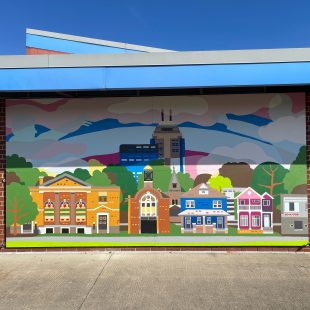Mari Evans:Carl Pope at Tube Factory artspace from Big Car Collaborative on Vimeo.
See photo documentation of the exhibit here.
Mari Evans:Carl Pope revolved around Indianapolis-based writer Mari Evans. One of the founders of the Black Arts Movement and longtime Indianapolis resident, Evans published her first work “Where Is All the Music” in 1968 followed by “I Am a Black Woman” in 1970. During this time, Evans also worked as a producer, writer, and director of “The Black Experience” (1968-1973) — a history documentary that aired on prime time in Indianapolis.
Located in the main Tube Factory gallery space, the exhibit was a co-curatorial project between Mari Evans, Carl Pope and Shauta Marsh. It consists of a commissioned installation piece by artist Carl Pope related to Evans’s photos, poetry and book of essays, “Clarity as Concept: A Poet’s Perspective.”
“I referenced the literary theories of Gerard Genette and the insights of scholar Valentine Cunningham to envision ‘Clarity as Concept’ as an Open Book whose narrative extends into the intertextuality of the astral and the casual aspects of the mind; the atomic, ethereal realm where previous reading, feelings and experience fosters transformation which determines the birth of unrecognized forms in the physical,” says Pope. “The text installation ‘A Reading of Mari Evans’ Book Clarity as Concept: A Poet’s Perspective’ and my ongoing meditation about it operate as a single work of visual art and alchemical literature…an active agent in psychic fusion and the evolution of cultural forms.”
Pope wrote an essay about Evans’s impact on his work and life, click here to read it.
This exhibit was made possible by the Andy Warhol Foundation for the Visual Arts, Alan Mills, Indiana Arts Commission and Sun King Brewery.
About Carl Pope
Carl Pope’s artistic practice is committed to the idea of art as a catalyst for individual and collective transformation(s). Pope’s multi-media installations were exhibited at prestigious venues including: The Museum of Modern Art and The Museum of Contemporary Photography in Chicago; receiving generous support from The Guggenheim Foundation, The Lilly Endowment, The National Endowment for the Arts, and The Louis Comfort Tiffany Foundation. The installations gained national and international exposure with “New Photography 6” at the Museum of Modern Art and “Black Male” at the Whitney Museum of American Art. Since 1990, Pope’s methodology with public art evolved into ongoing collaborative efforts with artists and communities, producing large-scale public art inventions that stimulate public dialogue and/or community revitalization. Excursions into his internal landscape produced the video/text installation “Palimpsest” commissioned by the Wadsworth Atheneum; with funds from The Warhol and Lannan Foundations, was included in the Whitney Biennial 2000. The essay of letterpress posters: “The Bad Air Smelled of Roses” and his recent billboard campaigns continue his ongoing exploration into public and inner space.
“Carl Pope’s work is at once a form of geography, re-imagining and imaging the forgotten histories, people and places in America, and a new psychology, creating a state of mind capable of sustaining the shocks of the present. It’s soul food for the mind, in sharp contrast to the quick hit of consumer pleasure that dominates the art market, and it’s all the more important for that.”- Nicholas Mirzoeff, Professor of Media, Culture, and Communications, NYU
About Mari Evans
Mari Evans’ mother passed away when Evans was 10 years old. Evans’ father immediately felt the need to encourage her in any way he could, cultivating her talent of writing that would later serve as her main career focus.
After attending public schools in her hometown of Toledo, Ohio, Evans attended the University of Toledo in the 1940s where she studied fashion design, but left without a degree. Evans’ interests shifted to writing poetry and by 1969 she was a writer-in-residence at Indiana University where she taught courses in African American Literature.
An influential member of the 1960s Black Arts movement, which included Amiri Baraka, Gwendolyn Brooks, Nikki Giovanni and Etheridge Knight, Mari published in 1969 her first work “Where Is All the Music?,” followed by her more famous “I Am a Black Woman” (1970). During this time Evans also worked as a producer, writer, and director of “The Black Experience” (1968-1973) – a history documentary that aired on prime time in Indianapolis. She also worked in theatre, adapting the musical “Eyes” (1979) from Zora Neale Hurston’s novel “Their Eyes Were Watching God” as well as writing a choreopoem, “River of My Song” and a one-woman theatre piece called “Boochie.”
Evans’ books for children include “Dear Corinne, Tell Somebody! Love, Annie: A Book about Secrets” (1999), “Singing Black: Alternative Nursery Rhymes for Children” (1998, illustrated by Ramon Price).
Evans also served as a consultant for the National Endowment for the Arts from 1969 to 1970. She published two collections of her poetry, “Nightstar: 1973-1978” (1981) and “A Dark and Splendid Mass” (1992). In 1984, Evans edited the first significant collection of black women’s poetry – the groundbreaking Black Women Writers (1950-1980). A new book of poetry “Continuum” was released in 2015.
Evans has taught at a number of other institutions including Cornell, Northwestern, Washington University in St. Louis, Spelman College, the University of Miami at Coral Gables, and the State University of New York at Albany. But she is best known for her poetry with her work has appearing in more than one hundred anthologies. Most of that work focuses on the celebration of Africa and the struggles of the Civil Rights Movement as well as other themes bringing to light the reality of the African American experience. These projects were largely influenced by close friend Langston Hughes, who pushed Evans to write with confidence and to evolve into a well-respected figure in the Black Arts Movement of the late 1960s and early 1970s.
The most important of her countless awards for writing came in 1981 when she received the National Endowment for the Arts Creative Writing Award.
Image: A Reading of Mari Evans’ Book, Clarity as Concept: A Poet’s Perspective, Carl Pope, 2016



